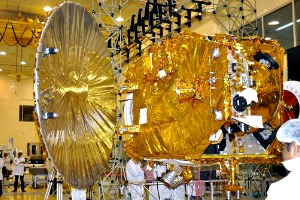"Our Mars mission cost less than the Hollywood movie Gravity."
Just a day after India’s Mangalyaan touched Mars’ orbit and space history was created for India and Asia, ISRO made images of the red planet public with the caption: “The view is nice up here.”
But what is the Mars Orbiter Mission, and is it useful to India as a developing nation struggling with other economic problems?
DESIblitz answers all your doubts, and has all you need to know about the Mars Orbiter Mission (MOM).
1. What is the Mars Orbiter Mission?
 The Mars Orbiter Mission (MOM), also called Mangalyaan ‘Mars-craft’ is a Mars orbiter launched into the Earth’s orbit on November 5, 2013 by the Indian Space Research Organisation (ISRO).
The Mars Orbiter Mission (MOM), also called Mangalyaan ‘Mars-craft’ is a Mars orbiter launched into the Earth’s orbit on November 5, 2013 by the Indian Space Research Organisation (ISRO).
It successfully entered Mars’ orbit on 24 September 2014, which has made India the first Asian nation to send a satellite to Mars, and the first nation in the world to do so on its first attempt.
2. How long did it take to reach Mars?
MOM took 300 days to finish the 200 million km expedition to Mars, which includes the 20-25 days it spent in the Earth’s orbit, building up the essential speed to break free from the gravitational pull.
3. Which other countries have successfully sent such orbiters to Mars?
Three space agencies, namely the US National Aeronautics and Space Administration (NASA), European Space Agency, and Russian Federal Space Agency have sent orbiters to Mars successfully.
India is now the fourth in the world, and the first in Asia, to send a successful Mars Orbiter.
The spacecraft takes 72 hours 51 minutes 51 seconds to go around the planet once.
4. What is the purpose of India’s space mission?
The Mars spacecraft will orbit the Red Planet, mapping its surface and studying the atmosphere. The observation has already begun using its scientific instruments, according to ISRO.

5. What scientific evidence is the MOM hoping to collect?
The search for methane in the Martian atmosphere is probably the most significant part of the MOM mission. Mangalyaan has gone equipped with an instrument that will try to measure methane in the atmosphere.
Earth’s atmosphere contains billions of tonnes of methane, the vast majority of it coming from microbes, such as the organisms found in the digestive tracts of animals.
The speculation has been that some methane-producing bugs could perhaps exist on Mars if they lived underground, away from the planet’s harsh surface conditions.
MOM will measure methane in the Martian atmosphere. So, even though Mangalyaan has a small payload, it will actually address some of the biggest questions on the Red Planet.
6. How much did the Mars Orbiter Mission cost?
 The Mars Orbiter Mission cost Rs. 450 crore (£46 million) in comparison to NASA’s Maven orbiter costing £413 million, which also successfully inserted itself into the Martian orbit on Monday 22nd September 2014.
The Mars Orbiter Mission cost Rs. 450 crore (£46 million) in comparison to NASA’s Maven orbiter costing £413 million, which also successfully inserted itself into the Martian orbit on Monday 22nd September 2014.
The Indian Prime Minister, Narendra Modi, even stated: “Our program stands out as the most cost-effective.
“There is this story of our Mars mission costing less than the Hollywood movie Gravity. Our scientists have shown the world a new paradigm of engineering and the power of imagination.”
7. Why is MOM so momentous for India?
MOM is India’s first interplanetary mission and displays ISRO’s technical aptitude in productively sending a spacecraft to Mars after foreseeing the challenges posed by the condition in proximity to the Earth and Mars and also a communication gap in between of almost 12 minutes.
8. How tough is the Mars Orbiter Insertion?
While nearing the Martian orbit, the velocity of the Orbiter has to be abridged accurately for it to be captured by the Martian orbit.
Roughly 60 per cent of Mars Missions have failed at this step. If the velocity is not adjusted accurately, then either the Orbiter will collide into Mars or it will be lost in space.
9. How quickly was the Mars mission pulled together?
 As India’s former Prime Minister Manmohan Singh announced India’s Mars goal in August 2012, ISRO started working at prompt speed and efficiency to engineer, bring together and launch the Mars Orbiter.
As India’s former Prime Minister Manmohan Singh announced India’s Mars goal in August 2012, ISRO started working at prompt speed and efficiency to engineer, bring together and launch the Mars Orbiter.
By November 2013, MOM was launched from Chennai and 10 months later, it reached Mars’ orbit thus creating history.
From the declaration to the implementation, the Mars mission took ISRO two years and a month, in comparison to NASA’s MAVEN, which was declared in September 2008, and contacted the Mars orbit just earlier this week, thus taking six years.
10. Why the criticism?
After India’s successful Mars mission, there was a supposition among many Western as well as Indian media and people, that space activity should be left to the wealthy, developed countries and that it can have no worth to the developing nations.
The argument was that money could be rather spent on healthcare and improved sanitation. But what was thus disregarded is that investment in science and technology builds competence and aptitude and helps develop the people who further profit the financial system and the society.
The developed nations already know that space activity is also a wealth producer, and have radically increased their spending on space activities in recent years.
India wants to be a part of this too, and through Mangalyaan and its other space missions, the nation is putting itself into a strong position in international markets for space products and services.
Hands down, ISRO has made India proud and hope it carries on to create more such opportunities in science and technology for coming generations.






























































